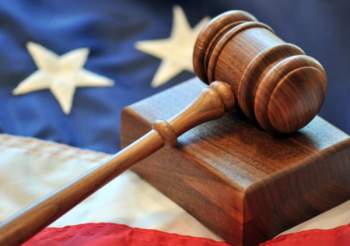
John Marshall

Popular In Supreme Court
How Many Supreme Court Justices Are There Justice Clarence Thomas Landmark Supreme Court Cases Supreme Court Building Us Supreme Court Docket Chief Justice John Roberts Hugo Black Justice Antonin Scalia Roger B Taney Supreme Court Justices Justice Elena Kagan Justice Sonia Sotomayor
Supreme Court Justice: John Marshall
John Marshall was the Chief Justice of the Supreme Court between 1801 and 1835. His court opinions helped create the foundation for constitutional law in America and made the United States Supreme Court a coequal branch of government with the executive and legislative branches. Previously, John Marshall had acted as the leader of the Virginia Federalist Party and also served in the U.S. House of Representatives between 1799 and 1800. Marshall was also the Secretary of State Adams from 1800 to 1801 under President John.
As the longest-serving Chief Justice in the history of the Supreme Court, John Marshall dominated the Supreme Court for over 30 years and played an important role in the evolution of the American legal system. His most noted contribution was reinforcing the idea that the federal courts were obligated to exercise judicial review, by discounting supposed laws if they violated the Constitution. Under Chief Justice John Marshall, the Supreme Court made many important decisions regarding to federalism, which affected the balance of power between the states and the federal government. Particularly, John Marshall confirmed the authority of federal law over state law multiple times, and he supported an expansive interpretation of the enumerated powers.
John Marshall served as the Chief Justice during six different administrations, where he participated in more than 1000 decisions, writing more than half of the opinions himself. Marshall helped to establish the Supreme Court as the highest authority on interpreting the Constitution in controversies and cases that had to be decided on by the federal courts. Soon after becoming the Chief Justice, John Marshall changed the way the Supreme Court announced decisions. Previously, each Justice would write a seriatim or separate opinion. Under John Marshall, the Supreme Court implemented the practice of handing a single opinion of the Supreme Court, allowing the opinion to present a clear rule. Since John Marshall was nearly always the author of these opinions, he effectively became the sole spokesman of the Court in important cases.
Famous Cases
Marbury v. Madison (1803): A landmark case by the Supreme Court and in United States law, as well as for worldwide law. The case created the basis for the power of judicial review by the judicial branch in the United States under the Constitution, specifically under Article III. This case also demonstrated the first time in Western history where a court nullified a law by pronouncing it unconstitutional, a process which is now called judicial review. The decision helped create and define the checks and balances found in American Government.
The case came out from a petition by William Marbury to the Supreme, who had been appointed as the Justice of Peace in the District of Columbia by President John Adams. However, the commission was not subsequently delivered to Marbury. Marbury then proceeded by asked the Supreme Court to force James Madison, the Secretary of State to deliver the documents. However, Justice Samuel Chase along with the Court and Chief Justice John Marshall denied the petition. Instead, the Court held that specific provision found in the Judiciary Act of 1789 which allowed William Marbury to bring forth his claim regarding the petition to the Supreme Court unconstitutional, because the act tried to extend the Supreme Court's original jurisdiction beyond the point which was established by Article III of the constitution.
The decision was a unanimous one that was based on three distinct questions: whether Marbury had the right to a commission, if the country’s laws could give a legal remedy to Marbury, and whether getting the Supreme Court to give a writ of mandamus was the correct legal remedy for this situation. John Marshall easily answered the first two affirmatively and found that the failure of the commission delivery violated a vested legal right. When John Marshall though about whether Marbury had a remedy, he stated the government could not let a vested legal right be violated and thus a legal remedy should exist for it.
When Chief Justice John Marshall looked at the third question, he first asked if a writ of mandamus was the correct legal remedy and if so, whether the Supreme Court could issue it. Marshall looked at the Judiciary Act of 1789 and decided that the Act’s purpose gave the Supreme Court original jurisdiction over the writs. He then looked to the Constitution, specifically Article III, which explains the original and appellate jurisdictions of the Supreme Court. Justice Marshall held that Congress did not have the authority to modify the original jurisdiction of the Supreme Court. Consequently, Chief Justice John Marshall found that the Judiciary Act and the Constitution conflicted. This raised the critical question of what to do when the Constitution conflicted with an act passed by Congress. Chief Justice Marshall answered that any conflicting acts were not law and the Courts are instead bound to follow the Constitution first, which affirmed the idea of judicial review.
Fletcher v. Peck (1810): A landmark Supreme Court unanimous decision where for the first time Court ruled a state law unconstitutional. This action helped start and create a precedent for the sanctity and importance of legal contracts, and implied that Native Americans did not actually hold title to their own lands. The case resulted in the Supreme Court, as well as Justice William Johnson, reaching a unanimous decision that ruled that the repeal by the state legislature of the law was not valid because of the unconstitutionality of the law.
The case revolved around a land grant that was approved by the Georgia legislature, called the Yazoo Land Act of 1795. Later it was revealed that the grant had actually been approved through bribery, and therefore the majority voters rejected many of the incumbents. The next Georgia legislature repealed the legislation and voided all succeeding transactions, including honest ones, resulting from the scandal. The opinion of the court, which was written by Chief Justice John Marshall, stated that a sale was a binding contract and could not be invalidated even if the contract was illegally secured, in accordance to the Contract Clause, or Article I, Section 10, Clause I of the Constitution. Chief Justice Marshall emphasized that the repeal would also seize property from those who had acquired it honestly, and would not provide compensation.Based on the principle of the separation of powers, Chief Justice John Marshall questioned whether the rescinding act could even be considered valid if even in the case that Georgia were a fully sovereign state independent of the national Constitution. Ultimately, Marshall’s opinion relied on the restrictions placed by the federal Constitution. This case resulted in the Court asserting its judicial right to invalidate a state law which was in conflict with the Constitution.
McCulloch v. Maryland (1819): A landmark Supreme Court decision which established two principles. The first of the two was that the Constitution gave Congress the implied powers to implement their will in order to make a functional national government. The second was that these powers and actions could not impede on any constitutional exercises of power performed by the federal government. This case resulted from an event where the state of Maryland tried to impede the operation of the Second Bank of the U.S. by placing a tax on all bank notes not chartered within the state.
While the law was generally applicable to all banks which were not chartered in Maryland, this particular bank was the only one existing in the state that was an out-of-state bank, meaning that the law specifically targeted this U.S. Bank. The Supreme Court determined that Congress did had the power to create the Bank. Chief Justice Marshall also refuted the argument that the states retain ultimate sovereignty since they ratified the constitution. He contended that it was the people who ratified the Constitution not the states, which made the people sovereign.
Chief Justice Marshall discussed the scope of congressional powers given under Article I. He addressed the necessary and proper clause and admitted that the Constitution did not enumerate a power to make a central Bank, but this did not mean Congress had the power to do so. Lastly, the opinion textually invoked the Necessary and Proper Clause, allowing Congress to try to meet an objective as long as it is within its enumerated powers and is not forbidden by the Constitution while it is rationally related to the objective at hand. With this interpretation, the court rejected Maryland’s extremely narrow interpretation of the clause, which assumed that "necessary" only meant that Congress could pass laws that were absolutely essential in executing its enumerated powers. Chief Justice Marshall ultimately determined that Maryland’s tax on the bank was unconstitutional.
Cohens v. Virginia (1821): A Supreme Court decision which is most noted for Chief Justice John Marshall and the Supreme Court's assertion of its power to look over state supreme court decisions regarding criminal law when plaintiff claims that their Constitutional rights were been violated. The Supreme Court had previously this jurisdiction over civil cases with American parties.
This case revolved around an act of Congress which approved the creating and operation of a District of Columbia lottery. The Cohen brothers started to sell these lottery tickets in the Commonwealth of Virginia, which violated state law. State authorities convicted the Cohen brothers, and the state courts said that the Virginia law which prohibited lotteries could be enforced, despite the act of Congress which allowed the D.C. lottery. The Cohen appeals appealed to the Supreme Court and argued that their actions were protected by the act passed by Congress.
The main issue in the suit was whether the Supreme Court had jurisdiction to hear the appeal of a criminal case which was decided by a state court. Virginia argued that the Constitution did not give the Supreme Court any appellate jurisdiction over criminal judgments made by the state courts. The state also argued that the Supreme Court did not have appellate jurisdiction according to the Constitution in cases which a state was a party. Effectively, Virginia believed that its decision was final and could not be reviewed by the federal courts,
Chief Justice John Marshall and the Supreme Court used Article III, Section 2 to determine that the Supreme Court did have appellate jurisdiction regarding any case and that there were no exceptions to this jurisdiction for state being a party. This conclusion was also reinforced by the Supremacy Clause found in Article VI of the Constitution, which placed federal law above state law. Knowing this jurisdiction, the Supreme Court upheld the Cohen brother’s convictions. The Supreme Court found that Congress did not mean to authorize lottery ticket sale outside of the D.C., so no conflict existed between Congress authorizing a lottery and Virginia prohibiting lotteries within the state.
Gibbons v. Ogden (1824): A landmark Supreme Court decision the court held that Congress had the power to regulate interstate commerce by the Commerce Clause found in the Constitution. The decision overturned a monopoly that was granted by the state legislature of New York to certain steamship companies operating between New Jersey and New York. Gibbons argued that since the Constitution gave Congress the congressional power to regulate interstate commerce, states did not have the concurrent power to do the same.
Chief Justice Marshall avoided discussing the issue about the exclusiveness of the federal commerce power because it was not necessary to look at in order to decide the case. Instead, John Marshall focused on the actual, existing federal statute that existed for licensing ships, and he stated that the federal law in place was a legitimate exercise of the Congress’ power to regulate interstate commerce, meaning that the federal law in place superseded the state law that granted the monopoly.
The court ruled in favor of Gibbons. Because the commerce clause was the most argued point of the case, the Supreme Court had to answer whether the Commerce clause exactly what was being regulated. The Supreme Court held that commerce was more than just traffic, but that it was the trade of commodities and it included navigation. The Supreme Court interpreted commerce “among” the states as that which intermingled with. Chief Justice John Marshall's ruling determined that Congress had the power to regulate navigation as a part of Congress and that this Congressional power could extend to all aspects of the regulation, which would override any state laws that were contrary to it. The immediate result of this decision was to use Congress’ power to end many monopolies that were granted by state laws. Doing so lowered prices, raised competition, and promoted free enterprise.
NEXT: A Short Biography on Justice John Paul Stevens





















